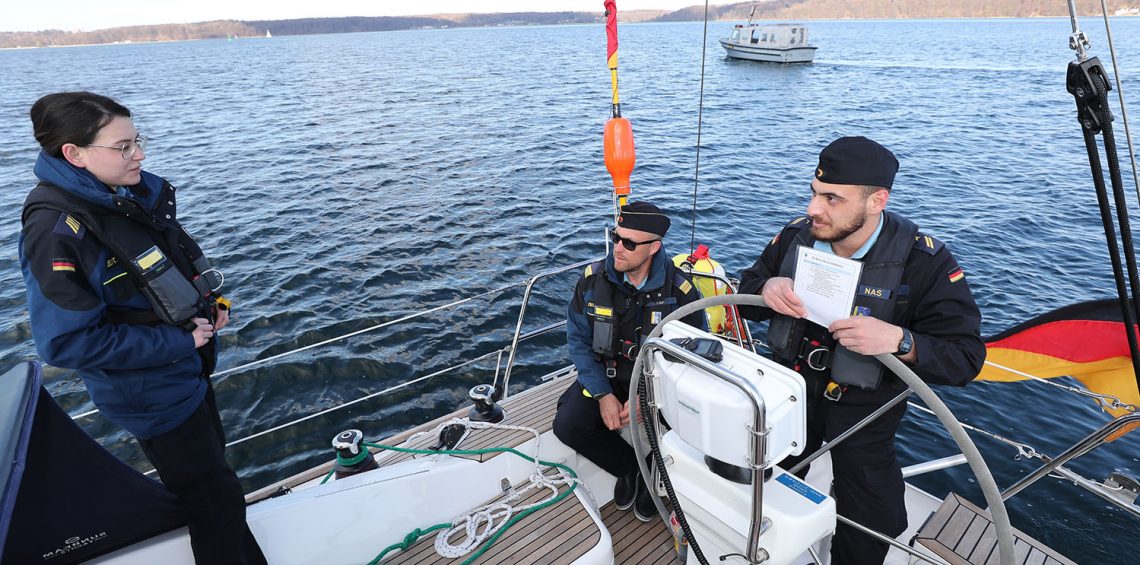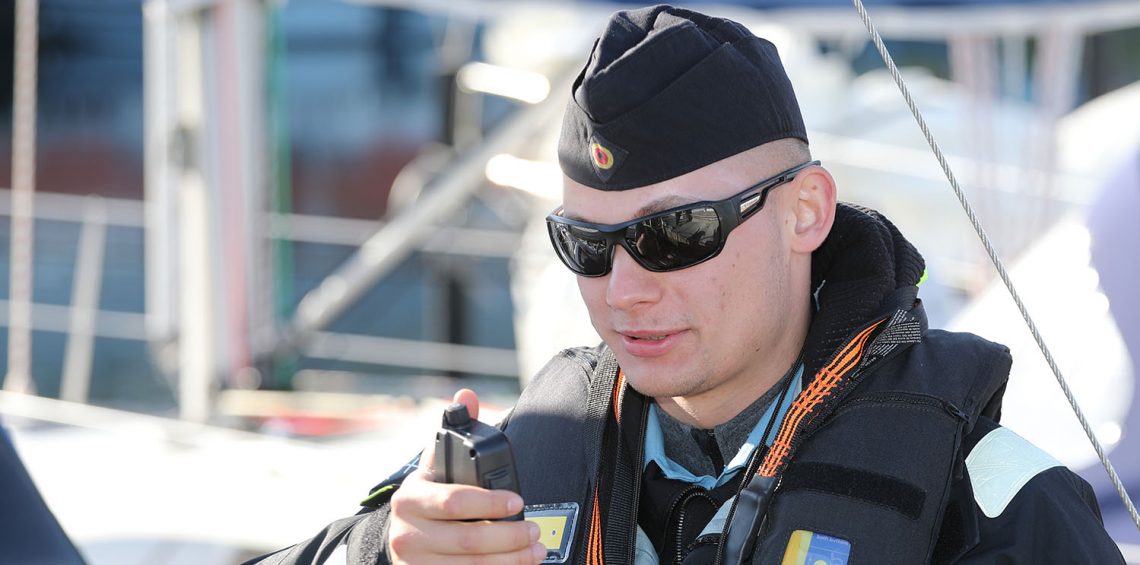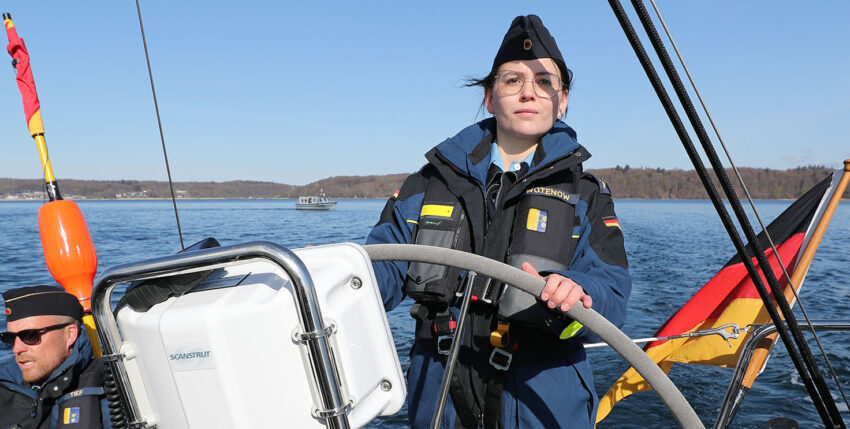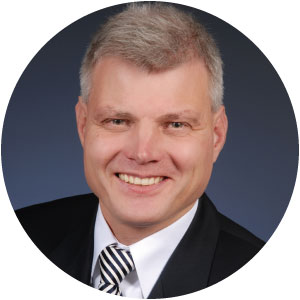An important part of the training at the Mürwik Naval Academy is the newly introduced military sailing training. This makes the modern Sunbeam boats irreplaceable aids.
A lot happened at the Mürwik Naval Academy's boat harbour in 2020. Firstly, seven new service sailboats were transferred to the use of the MSM last summer (see MarineForum 10/2020), while at the same time service sailing was reorganised under the title Military Sailing. Sailing training (MSA) was completely redesigned. Reason enough to take stock after one year. MarineForum met frigate captain Michael Hufnagel, head of seamanship at the MSM, and his number one seaman, lieutenant captain Stephan Tief, in Mürwik. Both have played a key role in the development and implementation of the concept of the Military Sailing training was involved. The interview took place on board the sailing boat Pollux, shortly before Tief set sail on a training voyage with four officer trainees (OAs).
Lieutenant Captain Tief, sailing has been part of officer training at the MSM since it was founded in 1910. What is new about the Military Sailing training?
Deep: The military Sailing training is much more than just sailing in uniform. It is a central and essential part of training to become a naval officer. We want to prepare OAs for their role as military leaders, instructors and educators - both in the field and in basic operations. The professional field of the naval officer is characterised by the sea dimension. This means that the thoughts and actions of naval officers must be determined by the sea. This principle is a timeless requirement for the training and education of naval officers. One key to realising this requirement, in addition to demanding theoretical training, is practical shipboard training. Training and further training on service sailboats emphasises the dependence on the sea dimension and the need to align one's own actions with current environmental influences. Nowhere else can space-time factors be taught so directly and immediately. Navigation, nautical law and experience from the simulator are put into practice on the small boats. Personal experiences at sea have a formative effect on the leadership behaviour of future naval officers, especially in stressful situations. We want to create experiences at sea that reflect team spirit, camaraderie and commitment and bind the OAs to our navy and the sea, just as the "Naval Compass" tells us all to do. The heart of the OAs should beat blue, so to speak, even if many of the OAs initially go ashore to study for four years after their officer training course.
The maritime character and many of the points you just mentioned are also reflected in the Gorch Fock sailing training ship, aren't they?
Hufnagel: Yes, that is correct. But neither the Gorch Fock nor the Military Sailing training separately from each other. The training cycle begins with the Sailing training at the MSM, continues with basic maritime-military training on the sail training ship and is complemented by internships on units in the fleet. We are therefore very pleased that the Gorch Fock will rejoin the training programme from late summer 2021. The sail training ship is an integral part of the practical shipboard training network and is of fundamental importance for the training of our junior staff. She simply belongs to the Mürwik Naval Academy. This means that the MSA cannot and should not replace the sail training ship, but rather complement it. With the MSA, we want to lay the nautical-seamanship foundation and familiarise the OAs with the standards of the fleet. The OAs should make consistent use of the command and reporting language, get to know a first organisation of the association with the boats and apply the principles of the doctrine of feel to a small crew. It is a valuable "aha" experience for the OAs to see how the theory from the lecture theatre is linked in practice and how theoretical knowledge is transformed into nautical-navigational skills. We call this linking the effective combination of on-board training.

So the MSA is less about passing sailing certificates and more about preparing the OAs for the grey fleet?
Hufnagel: The aim of the MSA is to provide competence-orientated training that enables the OAs to handle the boat and crew safely in nautical, navigational and technical terms. With the skills and abilities acquired, obtaining a sailing licence is almost a side effect. But in fact, the recognition value to the grey fleet is a declared goal. After completing their studies, the young officers build on what they have learnt, have already internalised certain standard formats and sea routines and can implement them - applied to their respective units - in their first A-grade assignment. The comparison with a seaworthiness survey according to the standards of the fleet is intentional. This creates confidence and trust in one's own abilities. For this reason, the MSA is organised in three phases. MSA I is comparable to an Isex, MSA II goes one step further as a dual ship exercise and MSA III is based on a Squadex.
This means that the military Sailing training is also a new challenge for the instructors. How do you prepare the skippers for this?
Deep: In addition to the MSM instructors, we have always relied on comrades from the troops and suitably qualified reservists. This will continue to be the case in the future. However, the MSA is no longer sailing under the motto "everything as usual". We attach more importance than before to the training qualities of the skippers. It is not enough just to be a good sailor, we also want good instructors to prepare officers and OAs for their future tasks and activities. Real leadership by example. To achieve this, we need to create a common pick-up point and familiarise all boat captains with the MSA concept. We will harmonise the training standard and ensure that the boat captains really do master everything they are supposed to teach. To this end, we bring in all external boat captains once a year for in-house training. All passionate sailors in the navy are welcome to train to our standards. B and C licence holders are cordially invited to contact me at this point.
Then the new service sailboats are just the right thing to be included in the Military Sailing training to be used. Were the Sunbeams 36.2 procured for this purpose, or how can this be?
Hufnagel: The boats are urgently needed, as practical on-board training is essential. In order to meet the personnel requirements of the navy, the naval school has also been training an increasing number of OAs in recent years. On the one hand, we had to respond to this increase in the number of crew by procuring additional crew, and on the other hand, the Nadine 24 and Hanseat 70B service sailboats have been in use for almost 40 years. We look after them well and continue to use them, but an expansion of the training fleet was necessary. Thanks to the influx of boats, we have generated around 25 additional training places. This means we can meet the increased training requirements and are fit for the future.
Together with the commander of the Gorch Fock, Captain Nils Brandt, whose commitment and expertise as a sailor were crucial to the success of the procurement, we carried out an intensive market analysis. In close cooperation with the Federal Office of Bundeswehr Equipment, Information Technology and In-Service Support (BAAINBw), and in particular with Martin Tenbergen, we drew up a specification in order to fulfil the requirements for a naval training boat. Above all, this included safety specifications regarding the equipment and strength of the superstructure as well as a CE seaworthiness classification in the highest category A. In addition, we deliberately did not want any furling sails, because the classic setting, hoisting and reefing of the sails is part of a well-founded training programme. Sailing training. For the same reasons, we have dispensed with lazy jacks or an anchor winch.
In the end, the Austrian Schöchl shipyard won the tender. Mittelmann's Werft in Kappeln carried out the final outfitting in accordance with the requirements of the navy. A certified quality assurance system consisting of construction supervision by Germanischer Lloyd and acceptance by the Berufsgenossenschaft Verkehrswirtschaft Post-Logistik Telekommunikation (formerly See-BG) rounded off the delivery. We are very pleased that the supplementary procurement went so quickly and smoothly. It is a positive example of the successful co-operation between the Navy, BAAINBw and civilian industry.

Mr Tief, you are a passionate sailor yourself and have your own boat. What do you think of the new training boats?
Deep: (laughs) The instructors and I are very enthusiastic about the new boats and their performance. Of course, a skipper who only knows Hanseatic boats has to get used to them. It starts with the change from tiller steering to wheel steering. After all, there are more than 40 years of yacht design between the Hanseat and the Sunbeam. The Sunbeams steer more directly, more dynamically and have a different manoeuvring behaviour when mooring and casting off. But you can also say that about class 122 and 124 frigates, on which I sailed as a nautical officer for a long time. With a length of 11.20 metres, we can use the Sunbeam in the entire North Sea and Baltic region, as they are much more seaworthy than the 7.50 metre Nadine 24, for example. The Sunbeam 36.2 is based on a Georg Nissen design from 2010 and is a further development of the Sunbeam 34, which in turn was voted "Europe's Yacht of the Year" in 2008. These advantages are also evident in our boats. The service life is designed for 30 years, meaning that these boats will become an integral part of the practical nautical training of many OA crews. And I am delighted about this as a sailor and as a naval officer.
Thank you very much for the interview and have a safe journey!
Frigate Captain d.R. Jan Heinsohn and Frigate Captain d.R. Oliver Kaus support the Sailing training at the Mürwik Naval Academy.










